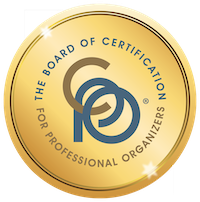Less stuff, more living: A review of Clutterfree with Kids (+ giveaway!)
Joshua Becker, the founder and editor of the popular Becoming Minimalist website, sent me a copy of his new book, Clutterfree with Kids for a review and giveaway. Here’s the review. At the end you’ll see how to enter to win an autographed copy of the book.
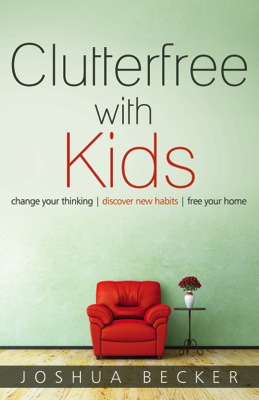
I’ve long extolled the virtues of living with less. I tell my clients and various audiences that less is more. Owning less stuff makes life easier. I sincerely believe that.
Reading Clutterfree with Kids, though, has given me even more perspective on it. I define clutter has having more items than you can comfortably store. Until now, I’ve always thought about excess in terms of whether or not stuff can be stored.
But Joshua Becker has me thinking about minimalism. That is, living with a fundamental philosophy of not just avoiding having too much, but rather embracing having as little as possible. That’s actually a pretty big shift. And it was an wow moment for me.
While this is a book focused on children’s possessions, the first third of it is about the concept of minimalism. And even if you (like me) don’t have kids, you might find it really interesting and, possibly, mind blowing.
Before he even gets into talking about kids’ stuff, Becker outlines his four steps for living in a clutterfree home.
- Believe it is possible
- Remove the excess
- Implement habits to manage your clutter
- Slow the accumulation of possessions
If you have kids, and you find the notion of teaching your kids the value of living with less intriguing, this book will give you many reasons to do it and will give you a way to go about it. The discussion isn’t limited to toys. It also includes chapters on clothing, artwork, sentimental items, collections, tv and video games, photos, gifts, packing, schedules, and preparing for baby.
I was especially delighted to read the chapter, “Clutterfree with a reluctant partner.” Minimalism is a huge lifestyle changed for many. What if your partner is not on board? Becker is full of sound advice, like “Refuse to let stuff separate you.” And “Realize you can’t change someone else. You can only change yourself (and your attitude).” He recommends leading by example, purging your own items first then looking for common items you can together agree to part with. And he recommends patience. Sounds spot on to me.
This book is well written, with lots of gentle humor. And it has what I believe is a profound message. If you’re at all enticed by the subject, I encourage you to read it.
The giveaway
Here’s how you can get a free copy of Clutterfree with Kids, autographed by the author. Just leave a comment below and/or tweet about the giveaway and/or post on your Facebook timeline or page about the giveaway. You’ll get extra entries for doing tweets and Facebook posts in addition to the comment. (Be sure and put my twitter handle, @janinea, in the tweet or, when you’re posting on Facebook, tag my Facebook page Peace of Mind Organizing so I’ll count your extra entries.)
Last day to enter is Friday, February 28. I’ll select the winner at random and announce the winner on my blog on Monday, March 3. (And I’ll contact you directly if you’re the lucky person.)
Decluttering Step #5: Put everything away

Here is the fifth and final entry in my Declutter Your Home blog series. Each Monday since January 20, I’ve covered a different step of the decluttering process: Step #1, Create your vision, Step #2: Choose your space, Step #3: Gather your supplies and Step #4: Ask key questions. This ends the series, but keep an eye out for future series!
If you’ve been reading this series and followed the steps, you’ve created your vision for your space, chosen a small but mighty place to start, gathered up your supplies and started making decisions about what to keep and what to let go of. This last step is critical, because it’s what’s going to stop you from finishing with a worse mess than when you started.
When you have a decluttering session, it’s important to reserve time at the end of the session for this clean-up step.
Here’s all you have to do: Put everything away.
- Put the keep stuff back into the space you decluttered.
- Throw away the trash
- Take out the recycling
- Put the donations in your car or call a charity for a pick up
- Take the stuff that belongs in other rooms back to those rooms
- Return any items that belong to other people
- Clean up your supplies
Even if you haven’t finished decluttering your space, put everything away. Then you can go about your business until your next decluttering session. Otherwise, you’ll be tripping over stuff. And worse yet, the items you segregated for disposal will somehow work their way back into the general population, so you’ll have to decide about them all over again. Trust me, I’ve seen this happen.
That’s it. If you follow these five steps in as many sessions as it takes to get through the areas you want to declutter, you’ll have a decluttered home. The next step will be organizing it. Keep an eye on the blog for a new series on organizing your decluttered space!
Five ways to make packing easy
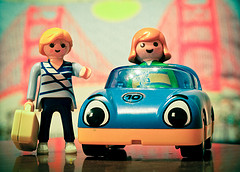
I travel every month or two and over the years I’ve managed to make packing fairly stress free. There are five practices that I’ve adopted that have helped make packing a piece of cake.
- I put together my outfits before I pack. I detailed my method in this blog post on avoiding overpacking but the basic point is that I plan my outfits before I pack and I don’t bring any more clothes than those that are needed for the outfits. It makes it easier to get dressed during the trip, too, since the decisions have already been made.
- I limit my shoes. I know, I know. That’s tough. But shoes are heavy and space-consuming. I try hard to bring no more than one or two pairs of shoes or boots beyond the pair I’m wearing while traveling.
- I keep a travel set of toiletries. I have travel-sized version of almost all my toiletries and they live in my toiletries kit. This way I save time packing and I don’t have to stress about forgetting something.
- I take only the makeup I need. It’s not practical for me to keep a travel set of makeup (it would go bad before I could use it up), but I just pack it into a makeup kit as I put it on the day of travel. Unless I’m going to a super-fancy event on my trip, I just take along this everyday makeup, not a whole bunch of different shadows or potions to choose from when I’m at my destination.
- I use a travel jewelry case. The Clos-ette Too Travel Jewelry Case makes it easy for me to take along what I need (and no more) and to see what I have brought. It also prevents my necklaces from getting tangled.
There are plenty of things to stress out about when traveling. Packing needn’t be one of them. By making decisions in advance and limiting my choices when I’m traveling, I make the process easier—and my bag lighter.
Photo by Susana Fernandez via Flickr
Decluttering Step #4: Ask key questions

This is the fourth in a blog series I’m writing on Mondays that will take you step by step through the decluttering process. Each Monday for the last few weeks, I’ve covered Step #1, Create your vision and Step #2: Choose your space and Step #3: Gather your supplies. Today we actually getting started decluttering.
If you’ve been reading this series and followed the steps, you’ve created your vision for your space, chosen a small but mighty place to start, and gathered up your supplies. Now it’s time to actually start decluttering.
If you have space, empty the area you want to declutter. (Remember, I suggest it be a small space like a drawer or a cupboard.) Sort the items so that like things are together. That way, you’ll discover your multiples. (When I decluttered my kitchen utensil drawer I was shocked to learn that I owned three pizza cutters!).
It should be relatively easy to part with all but one of the multiples. Pick the one you like best and put the rest in the donate box.
Then start going through each of the items and ask yourself the following three questions:
- Do I use it?
- Do I love it?
- Does keeping this item contribute to my vision for the space?
If you can honestly answer yes to any of the above questions, keep it. If you can’t, please consider letting it go. If it’s tough to let it go, try these two follow-up questions:
- If I let go of this item and I find I need it, will I be able to get another one?
- How likely is that to happen?
The three key questions should help guide you to letting go of the stuff you won’t miss. Don’t let these common objections derail you:
- I paid a lot for it. (The money is gone and keeping the item won’t bring it back.)
- It was a gift. (That doesn’t mean you have to keep it.)
- I might need it some day. (See the two follow-up questions, above.)
Place items in the appropriate boxes you’ve gathered (see Step #3), or the trash, until you’ve gone through them all.
Next week’s post, the final one in the series, will cover the next step.
Worth repeating: Too many choices
Having too many choices can be paralyzing, as I reflected in this post written two years ago, just before I bought my iPhone 4S.
I’m buying an iPhone this week. Yay! I’m a fan of Apple products and love my iPod Touch (which is a now a senior citizen) almost as much as I love my iPad. I adore my MacBook. And I hate my cheap little Android phone. So this week I’m going to invest in an iPhone and I’m really excited about it.
The problem is that I’m spending an inordinate amount of time deciding which carrier to go with. If I’d decided to buy an iPhone just two years ago, I would have had no choice. It was only offered by AT&T. That’s how it was when I bought my iPad and so I didn’t have to even think about options, once I’d decided to make the purchase. Buying an iPad meant just deciding on Wifi + 3g versus Wifi only (I went with the 3G option) and what storage capacity to get (16 gigabytes).
Now, with the iPhone, I have to decide which carrier, which plan, what storage capacity and what color (black or white). I’m having such a hard time with the carrier question that I’m tempted to delay the purchase.
That made me think about the fascinating article last August in the New York Times Magazine called Do You Suffer from Decision Fatigue, which talked about how difficult it is for consumers who are offered a wide variety of options.
My husband is in the market for a new personal computer. He’s a Windows guy. He was going to buy a computer almost three months ago but was paralyzed by all the options. I contrasted that to when I bought my most recent MacBook last fall and all I had to choose from was size (I went with 13”), Pro vs. Air (I went with Pro) and upper or lower tier of speed and capacity (I went with upper).
I purchased my MacBook with maybe a total of 30 minutes of contemplation. My husband spent hours on his PC purchase and still hasn’t bought one. (And at least one of those mind-numbing hours I was trying to help him. It was agony.)
My point here? Even a purchase like a new iPhone (which for me is extremely exciting) is turning into a bit of an exercise in frustration, with feelings of anxiety and insecurity arising, simply because there are so many options to consider.
It’s a good point to remember when I work with clients, many of whom spend much of their time with me making decisions. I need to keep the options clear and try not to throw too many options at them at once.
Decluttering Step #3: Gather your supplies

This is the third in a blog series I’m writing on Mondays that will take you step by step through the decluttering process. Each Monday for the next few weeks, I’ll offer a new step. So far, we’ve covered Step #1, Create your vision and Step #2: Choose your space. Today’s step is the last preparatory step before actually getting started decluttering.
You’ve created your vision for your decluttered home. You’ve decided what small space to start with. Now it’s time to gather up your supplies. And, no, I’m not talking about the storage and organizational solutions you’ll eventually organize your space with. I’m talking about a few ordinary boxes and bags.
For the decluttering process, the supplies you need are very simple:
- 5 boxes
- a supply of large trash and/or recycling bags
- a timer
If you want to get a little fancy and you know you’re going to be doing a lot of decluttering, you might buy a pop up lawn and leaf bag holder to keep your trash/recycling bags open and easy to use. (I also use them for filling up donation bags.)
(Notice that none of the supplies including organizing solutions. Wait until after the decluttering process to purchase those!)
Mark the boxes with the following categories. You can use Post-It® Notes or just write on them with a marker.
- Keep
- Donate
- Recycle
- Relocate to Another Room
- Other (for items that need to be shredded, mended, or returned to their owner, depending on the kind of space you’re decluttering)
The Relocate to Another Room box is vital. How many times have you walked to another room when you were decluttering in order to return an item to its proper home ? Did you then get distracted by items in that room and go off track? Use the Relocate to Another Room box to keep yourself physically in the space you’re working on. Simply put any item that belongs elsewhere in the house into this box, then budget time at the end of the session to put that stuff away.
The timer is also really valuable. Timers keep you focused, get you past that overwhelmed feeling, and allow you to keep track of time so you don’t end the session suddenly, leaving a big mess behind.
This third step was the last prep step. Next week we’ll talk about the decluttering process.
Ten minutes to calm
Yesterday afternoon, I sat down at my cleared-off desk (I’d cleared it because the housecleaner was coming that morning), and proceeded to trash it. I don’t know what happened—I think I was looking for something I’d written down but couldn’t find. Plus I’d probably dumped some stuff on the desk when I came home. (Yikes.)
I eventually found what I was looking for and turned my attention to my computer screen so that I could get some work done, but the stuff remained all over my desk.
I didn’t really need to use my desk’s surface—my work was focused on my computer—but I still couldn’t get anything done. The ideas weren’t flowing. I was distracted by my messy desk.
So after an hour or so of spinning my wheels, I decided to do something about the desktop. Good organizer that I am, I took a before picture. Then I pressed play on a ten-minute playlist in iTunes and I started putting stuff away. And throwing stuff away. I made file folders and filed a few papers. I added some items to my task list.
Here’s what happened in just ten minutes:
Messy desk before:
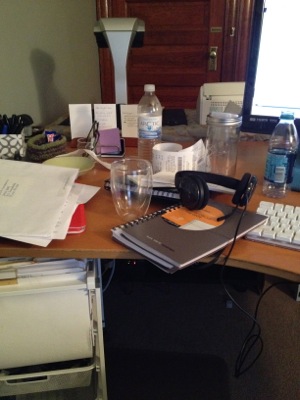
Just ten minutes later:
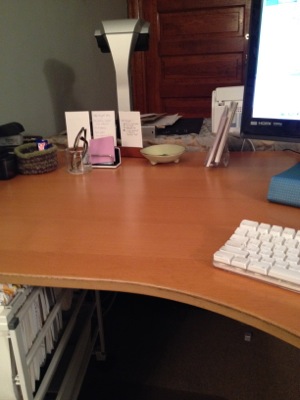
I’m continually impressed with how powerful just a small amount of time decluttering can be. The trick is to pick a small space and finish in the allotted time—don’t leave it half done. The other trick is to do it fairly often; I dealt with yesterday’s clutter so quickly because it was not very deep.
Take a look around the room you’re in. Is there a little space (a shelf? a surface?) that you could declutter this weekend? Trust me, it’ll feel so good.
Links
- Organize Your Family History
- Getting to Good Enough podcast
- Ravelry
- National Association of Productivity and Organizing Professionals
- Peace of Mind Spending
- Shannon Wilkinson, life coach
- NAPO St. Louis
- Institute for Challenging Disorganization
- Are you interested in becoming a professional organizer?








